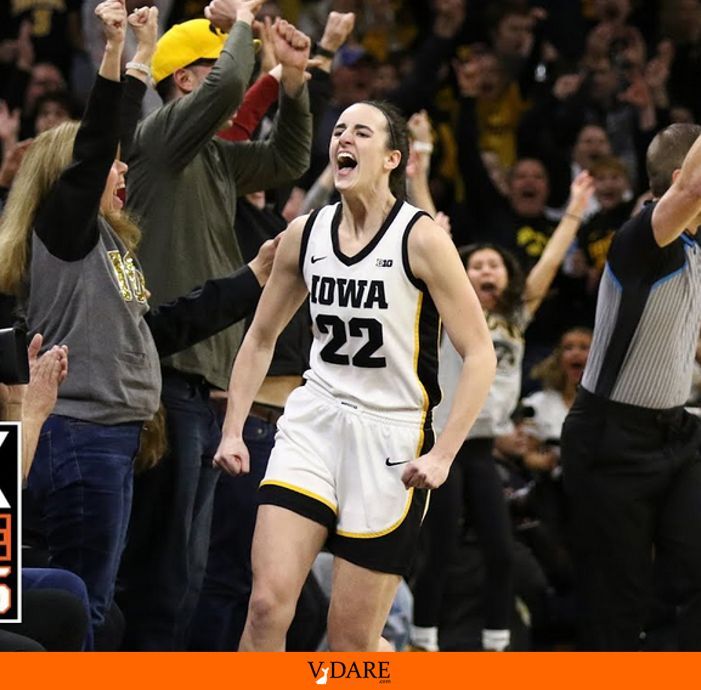
03/17/2024
Women’s college basketball is popular at the moment in sizable part because of Caitlin Clark, a record-setting 6’0″ guard at the #2 ranked U. of Iowa who is sort of the Stephen Curry of women’s basketball, shooting from 35′ or more:
From the USA Today sports section:
Women’s basketball needs faces of future to be Black. Enter JuJu Watkins and Hannah Hidalgo
by Lindsay Schnell
USA TODAY… With Caitlin Clark headed to the 2024 WNBA draft, where she’s projected No. 1 overall, Watkins, the nation’s second leading scorer this season behind Clark, is positioned to become the face of women’s basketball. She’ll be joined by Notre Dame point guard Hannah Hidalgo, the other favorite for freshman of the year.
Not lost on any of the powerbrokers in the game: Both of these players are Black. And in a game built by Black women, it matters that the faces of the future look like the faces of the past.
Over the past few years, as women’s basketball has exploded in popularity, much of the media and marketing attention has focused on three prominent white players: Clark, UConn junior Paige Bueckers and Oregon’s Sabrina Ionescu, who graduated in 2020.
Too often, the Black players who built women’s hoops — and who now dominate the professional level, where the WNBA is 70% Black — haven’t been acknowledged. Occasionally their existence has been wiped from the record books completely, like with former Kansas standout Lynette Woodard’s Division-I scoring record not being recognized by the NCAA.
“I don’t think it’s anyone’s fault or been anyone’s intention,” Southern Cal coach Lindsay Gottlieb told USA TODAY Sports. “But there haven’t been enough commercial endorsements of Black female superstars in our society, period.”
As women’s basketball grows in popularity, white players get most attention
… Consider that power forward A’ja Wilson, arguably the best player in the world, whose award résumé is longer than a Walgreens receipt, doesn’t have near the star power of Clark.
And then there’s the contemporary ritual of white people winning awards having to make speeches demeaning themselves, explaining that blacks really deserve all the plaques:
… During a speech at the 2021 ESPYs, Bueckers acknowledged as much, saying, “With the light I have now as a white woman who leads a Black-led sport … I want to shed a light on Black women. They don’t get the media coverage that they deserve. They’ve given so much to the sport, the community and society as a whole and their value is undeniable.”
I suspect, in reality, the future of women’s sports is biggest in more rural states like Iowa and Nebraska, where the U. of Nebraska packed over 90,000 into their football stadium for a women’s volleyball match as a show of local pride to set a record for women’s sports attendance.
The popularity of college sports in a locale tends to be inversely correlated with the number of professional sports teams. For example, the U. of Alabama has had the top college football team of recent years in part because Alabama doesn’t have major league cities, so the state’s energies are focused on its Alabama’s college football team.
Similarly, college football was big in Los Angeles during that strange interregnum when L.A. went from two NFL teams to none for a couple of decades, before recently going back to two. Now, with two NFL teams in L.A., UCLA football has become notorious for terrible attendance.
The U. of Nebraska won national football championships in the 1970s and 1990s, but lately seems past its prime in the big sport. So Nebraskans have gotten into women’s volleyball as something their state flagship college has a reasonable chance of winning a national championship in. They’ve won five national championships over the last half century, an average of about one per decade. That seems like a fair trade-off: if you root for your home team in a minor sport for a decade, you ought to be able to expect they will win the big one once during your ten years.
Of course, that means you need a lot of minor sports for those kind of odds. But that’s okay. It’s nice to have a lot of different sports so a lot of different places can have a winner in something or other.
Women’s sports tend to be a byproduct of strong two-parent families. Women athletes tend to have close relationships with their dads. So, women’s sports at state flagship universities tend to represent the Good Families.
This is a content archive of VDARE.com, which Letitia James forced off of the Internet using lawfare.